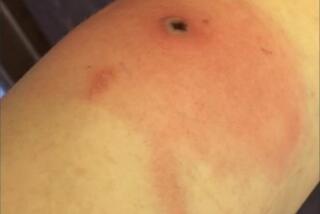Infant and fetus burial offers clues to ice age settlement
The curled-up bodies of a stillborn fetus and a 5-week-old infant buried in a dune beside an Alaska river are being hailed as the oldest known remains of Native Americans who crossed from Asia during the last ice age.
The two, who might have been related by blood or band membership, had been buried side by side in a circular pit, along with carved hunting spears, several feet below a subsequent cremation of another child, according to a study published online Monday in the journal Proceedings of the National Academy of Sciences.
Carbon dating suggests all three died about 11,500 years ago, give or take a few years, during summer occupation of the Upward Sun River site along the Tanana River in central Alaska, according to the study.
“This represents the oldest known human remains that have been found in the northern North America - the arctic and sub-arctic,” said archaeologist Ben Potter of the University of Alaska, Fairbanks, lead investigator of the study.
The remains also represent the youngest-aged specimens and the only fetus to be unearthed in the region, according to the study. Both are presumed to be female, based on characteristics of the jaws and pelvis. The sex could not be determined from the scant remains of a cremated 3-year-old child discovered in 2010 at a shallower level of the same pit.
The spear fore-shafts, shaped from antelope horns and decorated with abstract etchings, were in close contact with stone points that were beveled on both sides. They bear striking resemblances to implements found in northeast Asia, lending support to theories that the first occupants of North America crossed a land bridge across the Bering Sea when sea levels fell during the last ice age.
“The technology links Alaska and the Yukon territory with Asia,” Potter said. “It really looks Asian.”
Researchers say the two burials, along with a later one excavated from the same pit, offer intriguing clues to burial practices related to belief systems of the early ancestors of northern Native Americans.
The implements, which also included a knife-like blade, represented an investment in time and technology, and their burial presumably would have been a relatively costly sacrifice.
There is a remote chance that the buried pair were twins – one stillborn, one surviving for several weeks, Potter said. But DNA analysis has not been completed, he added. All three burials likely occurred within a short enough time period, he added.
If not related by blood, the dead probably were members of the same cultural group, possibly of one small band, according to the study.
There are several hundred dunes at the site, all of them quite large, making it “highly unlikely” that two families or bands coincidentally occupied the same dune in subsequent seasons, Potter said.
“Either you have this occurring in the same summer, or perhaps subsequent summers, but very close,” Potter said.
The uniformity of food remains in the hearth sediments – mostly salmon and small game - suggests that occupants settled down during the summer months when the fish and small game were plentiful, but still hunted larger animals, such as bison and wapiti, using spear systems.
Early occupants probably had an indoor hearth over the first burial pit, but later abandoned both hearth and home after the death and cremation of the third child, according to the study.
Why the first two children were buried with the hunting tools while the third was just cremated and covered over without any offerings remains a mystery. Researchers said they could rule out differences based on separate cultures or different burial seasons – such as cremation in winter, when soil is too hard to dig.
The infant was found lying on its back with its legs tightly curled to its chest, while the burial position of the fetus was more difficult to determine – it could have been similarly curled and buried in a sitting position, or its fragile bones were partially scattered by compression after burial, the study said.
The fetus appears to occupy a more central position in the pit, in contact with the spears, while the second was found somewhat toward the side of the grave. That could mean the grave was dug up after the second child died and buried next to the fetus – possibly to reunite twins.
Dig science? Follow me on Twitter: @LATsciguy







